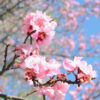**The Spiritual Significance of Cherry Blossoms in Buddhism**

Cherry blossoms, known as “sakura” in Japanese, hold profound spiritual symbolism within the context of Buddhism, particularly in Japanese Buddhism. Let’s explore the spiritual significance of cherry blossoms in Buddhism:
1. **Impermanence (Anicca):** In Buddhist philosophy, the transient nature of life is a central tenet. Cherry blossoms, with their ephemeral beauty and short-lived bloom, serve as a poignant reminder of the impermanence of all things. They symbolize the Buddhist concept of “anicca,” teaching practitioners to appreciate the present moment and accept the inevitability of change.
2. **Transcendence:** Cherry blossoms are often associated with the Buddhist concept of transcendence, representing the transition from the material world to the spiritual realm. The fleeting nature of the blossoms reflects the impermanence of the physical body, while their ethereal beauty suggests the possibility of spiritual enlightenment and liberation from suffering.
3. **Renewal and Rebirth:** In Buddhist tradition, cherry blossoms are seen as harbingers of spring, a season symbolizing renewal, rebirth, and the cycle of life. The blossoms’ emergence after the dormant winter months signifies the eternal cycle of death and rebirth, reminding practitioners of the continuous process of spiritual growth and transformation.
4. **Purity and Enlightenment:** Cherry blossoms are revered for their purity and pristine beauty, qualities that align with the Buddhist ideal of spiritual purity and enlightenment. In Japanese Buddhism, the image of the Buddha surrounded by cherry blossoms is a common motif, symbolizing the enlightened state of being free from defilement and suffering.
5. **Mindfulness and Contemplation:** The ephemeral beauty of cherry blossoms inspires mindfulness and contemplation in Buddhist practice. Observing the blossoms’ brief but breathtaking bloom encourages practitioners to cultivate awareness of the present moment and reflect on the transient nature of existence, fostering a deeper understanding of Buddhist teachings.
6. **Harmony with Nature:** Cherry blossoms exemplify the Buddhist principle of living in harmony with nature. Their graceful bloom and graceful fall serve as a reminder of the interconnectedness of all living beings and the importance of respecting and cherishing the natural world.
7. **Cultural Reverence:** Across Buddhist cultures, cherry blossoms are revered for their cultural significance and spiritual resonance. In Japan, cherry blossom viewing, or “hanami,” is a cherished tradition that brings people together to celebrate the beauty of nature and contemplate life’s impermanence.
In summary, cherry blossoms hold deep spiritual significance in Buddhism, symbolizing impermanence, transcendence, renewal, purity, and enlightenment. Through their ephemeral beauty and timeless symbolism, cherry blossoms inspire mindfulness, contemplation, and a deeper connection to the spiritual teachings of Buddhism.
**Part 2: The Spiritual Significance of Cherry Blossoms in Buddhism**
Continuing with the exploration of cherry blossoms in Buddhism, let’s delve deeper into their spiritual significance within the context of the Buddhist tradition:
8. **Meditative Practice:** Cherry blossoms often feature in Buddhist meditative practices, serving as objects of contemplation and reflection. The act of observing the delicate petals drifting in the wind can induce a meditative state, helping practitioners cultivate mindfulness, concentration, and inner peace.
9. **Offerings and Devotion:** In Buddhist rituals and ceremonies, cherry blossoms are frequently used as offerings to honor the Buddha and express devotion. Their fragrant scent and elegant appearance symbolize sincerity, reverence, and the aspiration for spiritual awakening.
10. **Symbol of the Buddha’s Teachings:** Cherry blossoms are regarded as symbols of the Buddha’s teachings, known as the Dharma. Just as the blossoms flourish and fade in accordance with natural law, the Dharma elucidates the universal truths of impermanence, suffering, and the path to liberation, guiding practitioners on the journey to enlightenment.
11. **Celebration of Vesak:** During Vesak, the most significant Buddhist festival commemorating the birth, enlightenment, and death of the Buddha, cherry blossoms play a prominent role in decorations and offerings. They symbolize the joyous occasion of the Buddha’s birth and the spiritual renewal that comes with his enlightenment.
12. **Inspirational Metaphor:** Cherry blossoms serve as an inspirational metaphor in Buddhist teachings, illustrating profound spiritual principles through their natural beauty and transience. Just as cherry blossoms bloom vibrantly for a brief period before fading away, so too do our lives unfold with moments of joy and sorrow, ultimately leading to spiritual awakening and liberation.
13. **Cultural Legacy:** Across Buddhist cultures, cherry blossoms are deeply ingrained in the cultural heritage and artistic expression of the faith. From poetry and literature to painting and sculpture, cherry blossoms continue to inspire creative endeavors that reflect the enduring spiritual values of Buddhism.
14. **Universal Symbol of Hope:** Beyond the confines of Buddhism, cherry blossoms have become a universal symbol of hope, renewal, and the resilience of the human spirit. Their timeless beauty transcends cultural boundaries, uniting people of diverse backgrounds in appreciation of life’s fleeting yet precious moments.
In conclusion, cherry blossoms hold multifaceted spiritual significance in Buddhism, symbolizing mindfulness, devotion, the Buddha’s teachings, and the universal truths of impermanence and enlightenment. As timeless emblems of beauty and spirituality, cherry blossoms continue to inspire practitioners and admirers alike to contemplate the deeper mysteries of existence and embrace the profound wisdom of Buddhist teachings.


